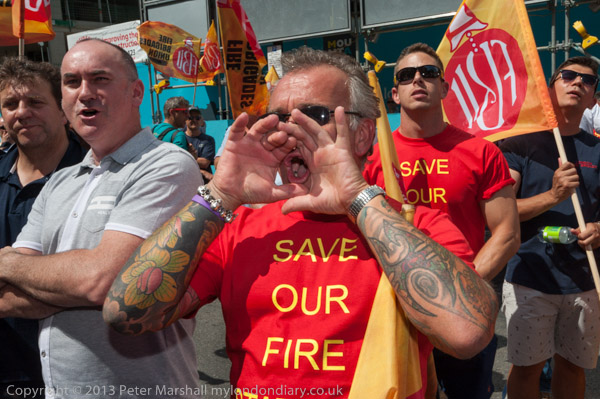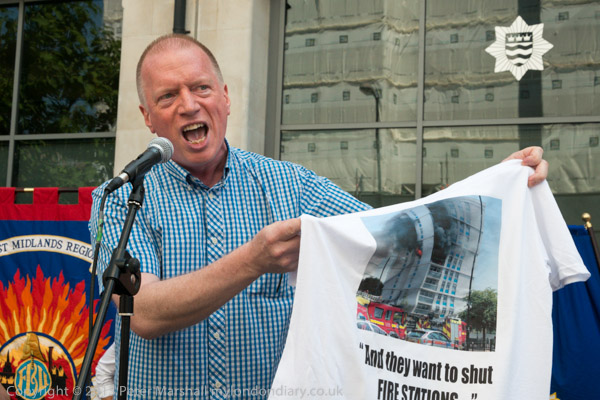Fire Service Cuts Cost Lives: On Thursday 18th July 2013 I photographed a march and rally by the Fire Brigades Union in London against cuts proposed by then London Mayor Boris Johnson. He had in 2010 repeatedly denied that he would make any cuts to London’s fire services, but the cuts which this protest was against led to the closure of ten fire stations in Greater London and the loss of over 550 firefighters in the force.

There was also a loss of the number of fire engines, at first of 14, but followed later by another 13, a cut of around 15%. Unsurprisingly the response times to fires across the capital increased. The first fire engine should arrive within six minutes of a fire being reported, and in late 2014 the figures showed that this was exceeded in around a third of London’s wards. Although the average increase in response times was only 12 seconds, in the worst case it went up by two minutes and 48 seconds.

Fast response to fires is essential in saving lives and cutting damage to properties, and although fortunately few lives are lost to fire in London thanks to our firefighters it seems that there was at least one fatality in the following year which was widely attributed to a slower response time. As I wrote in 2013, “7 out of 10 Londoners think that the Mayor’s proposed cuts will put public safety at risk, and the remaining 3 are just not thinking.”

In our great 2017 tragedy at Grenfell Tower, the fire service responded promptly, but it took over half an hour for a turntable ladder to arrive, and at the time the LFB only had ladders that reached under half way up that building. They called in a taller ladder from Surrey which took several hours to arrive. The LFB finally got its first 64m turntable ladder, the tallest in the UK, in 2021.

Appropriately the march began at The Monument, a 202ft column topped by a bright brass ball of fire erected shortly after the 1666 Great Fire of London as a permanent memorial to the event.

Fire-fighters, many in uniform, and supporters gathered in the area around, along with a fire engine and a small marching band with bagpipes sponsored by an FBU branch. London’s own firefighters were supported by some for other brigades, including at least a couple from the New York Fire Department as well as retired fire-fighters and anti-cuts protesters.

When the march which went across London Bridge to the London Fire Brigade HQ in Southwark for a rally outside where the cuts were being decided at a Fire Authority meeting I had gone up on top of the fire engine.

What I hadn’t realised was that I would be unable to get down until the end of the march, and although it gave me a good viewpoint it was in some ways a limiting one. I always like to take most of my pictures close to people using wide-angle lenses and during the march was unable to do so. And when the marchers sat down briefly to block London Bridge I could only watch from a distance.

I’d also not realised how much vibration there would be on the top of the fire engine, where we were in a fairly small enclosure made with scaffolding tubing on its top. I found myself having to hang on tightly in some of the bumpier parts of the roads, while trying to take pictures largely one-handed.

It was a rather uncomfortable and just a little scary experience, but it did take me close to some of those who had come to first and second floor windows to applaud the protest as it went past. But I was very pleased when we came to a stop at the Fire Brigade HQ and I could get back to ground.

You can read more about the rally at the end of the march and a long list of the speakers on My London Diary and there are photographs of most or all of them as well as many more from the event.
Fire Service March Against Cuts
Flickr – Facebook – My London Diary – Hull Photos – Lea Valley – Paris
London’s Industrial Heritage – London Photos
All photographs on this page are copyright © Peter Marshall.
Contact me to buy prints or licence to reproduce.






